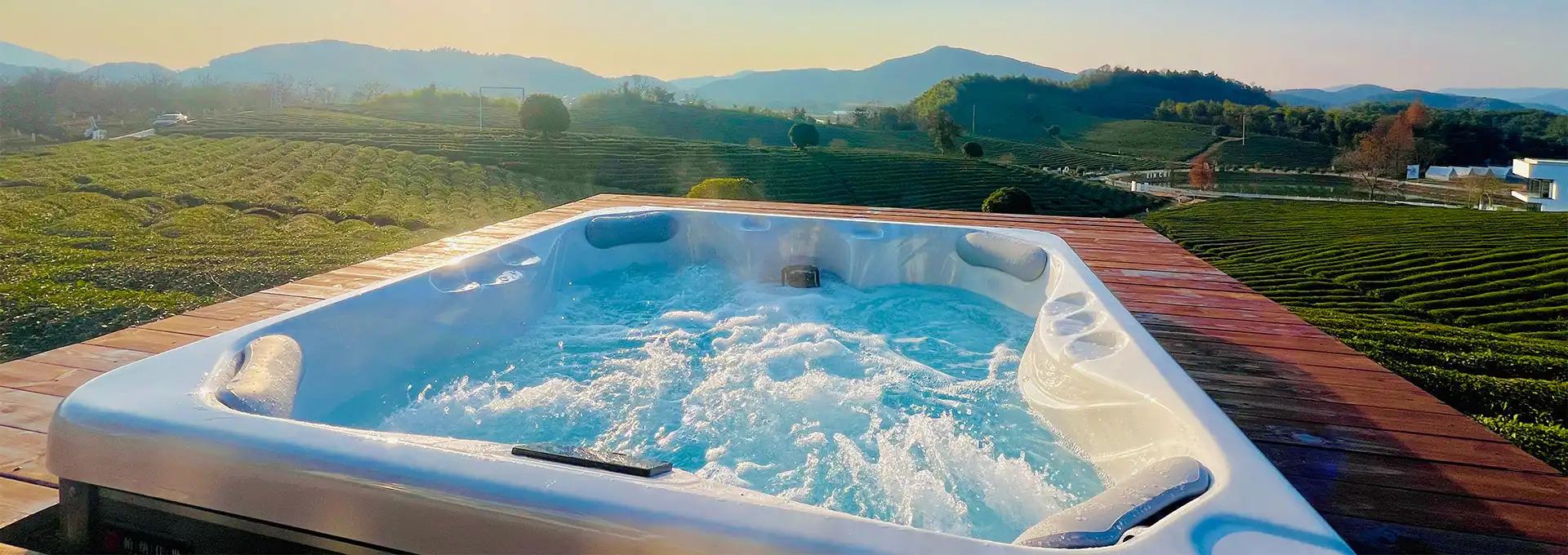How Many Watt Generator to Run Large Hot Tub?
2025-04-28 10:18:04
When it comes to enjoying a comforting soak in a large hot tub, one of the crucial considerations is icing you have the right power source to keep it running easily. For those who want to use their hot hogshead in remote locales or during power outages, a creator can be an excellent result. still, determining the applicable wattage for a creator to run a large hot hogshead can be grueling . In this blog post, we'll explore the factors that impact creator size conditions for large hot barrels and give guidance on opting the right creator for your requirements.
What size generator is needed for a large hot tub?
Determining the power requirements of your hot tub
Before selecting a generator for your large hot tub, it's crucial to understand the power requirements of your specific model. Large hot tubs typically require between 6,000 and 8,000 watts to operate efficiently. This includes powering the heating element, pump, and other electrical components. To determine the exact power needs of your hot tub, consult the manufacturer's specifications or look for a label on the unit that indicates its power consumption. Keep in mind that the initial startup of a large hot tub may require even more power, sometimes up to 1.5 times the running wattage. This surge in power demand is due to the electrical components drawing extra current when first activated.
Factors affecting generator size for hot tubs
Several factors can influence the size of the generator needed to run a large hot tub effectively. One of the most important considerations is the climate in which you'll be using the hot tub. In colder regions, the heater will need to work harder to maintain the desired water temperature, potentially requiring a larger generator. Additionally, the frequency of use and the number of people using the hot tub simultaneously can impact power consumption. If you plan to use other electrical devices alongside your hot tub, such as outdoor lighting or a sound system, you'll need to factor in their power requirements as well. It's also worth considering the generator's fuel efficiency and runtime, as these factors can affect your overall experience and maintenance needs.
Recommended generator sizes for large hot tubs
For most large hot tubs, a generator with a minimum output of 8,000 to 10,000 watts is recommended. This size should provide sufficient power to run the hot tub and handle any initial surge in demand during startup. However, if you live in a particularly cold climate or plan to use additional electrical devices, you may want to consider a generator with a higher output, such as 12,000 to 15,000 watts. It's always better to have a generator with slightly more capacity than you need rather than one that struggles to meet your power demands. When selecting a generator, look for models with features like automatic voltage regulation and low total harmonic distortion to ensure a stable power supply that won't damage your hot tub's sensitive electrical components.
How does hot tub size affect generator requirements?
Comparing power needs for different hot tub sizes
The size of your hot tub plays a significant role in determining the generator wattage required to power it effectively. Smaller hot tubs, typically accommodating 2-4 people, may only need 4,000 to 6,000 watts to operate. Medium-sized hot tubs, which can fit 4-6 people, generally require 6,000 to 8,000 watts. Large hot tubs, designed for 6-8 people or more, often need 8,000 to 10,000 watts or higher. These larger models typically have more powerful pumps, larger heating elements, and additional features that contribute to increased power consumption. When considering a generator for your large hot tub, it's essential to account for this increased power demand to ensure a seamless and enjoyable experience.
Impact of hot tub features on power consumption
The features and accessories included in your large hot tub can significantly impact its power requirements. High-end models often come equipped with advanced jet systems, multiple pumps, LED lighting, audio systems, and even built-in televisions. Each of these features adds to the overall power consumption of the hot tub. For example, a large hot tub with a powerful jet system and multiple pumps may require an additional 1,000 to 2,000 watts compared to a more basic model of the same size. When selecting a generator, consider not only the size of your hot tub but also the specific features it includes. This will help ensure that your generator can handle the total power load, including any luxury amenities you may want to use while enjoying your hot tub experience.
Balancing hot tub size and generator capacity
Finding the right balance between your large hot tub's size and the generator's capacity is crucial for optimal performance and enjoyment. While it may be tempting to choose a generator with just enough power to meet your hot tub's minimum requirements, this approach can lead to problems in the long run. A generator that's constantly operating at its maximum capacity is more likely to experience wear and tear, potentially leading to shorter lifespan and increased maintenance needs. Additionally, a generator that's barely meeting the power demands of your large hot tub may struggle to maintain consistent performance, especially during cold weather or when multiple electrical components are running simultaneously. To ensure a reliable and efficient power supply for your large hot tub, it's generally recommended to select a generator with a capacity that exceeds your estimated power needs by at least 20%.
What are the best generator options for powering a large hot tub?
Portable vs. standby generators for hot tubs
When it comes to powering a large hot tub with a generator, you have two main options: portable generators and standby generators. Portable generators offer flexibility and can be moved as needed, making them ideal for occasional use or in situations where you might want to use the hot tub in different locations. They're generally less expensive than standby generators but may require manual setup and refueling. Standby generators, on the other hand, are permanently installed and can automatically detect power outages, making them a more convenient option for regular use. They typically offer higher power output and can run on natural gas or propane, eliminating the need for frequent refueling. While standby generators are more expensive upfront, they can provide peace of mind and consistent power for your large hot tub, especially if you live in an area prone to frequent power outages.
Top generator brands for large hot tubs
Several reputable generator brands offer models suitable for powering large hot tubs. Honda is known for its reliable and fuel-efficient portable generators, with models like the EU7000iS providing ample power for most large hot tubs. Generac offers both portable and standby generators, with their GP8000E portable model and Guardian series standby generators being popular choices for hot tub owners. Briggs & Stratton is another trusted brand, offering generators like the Q6500 QuietPower Series Inverter Generator, which combines power and quiet operation. For those seeking a more eco-friendly option, Goal Zero offers solar-powered generators that can be used to run large hot tubs in remote locations. When choosing a generator brand for your large hot tub, consider factors such as power output, fuel efficiency, noise levels, and warranty coverage to ensure you select a model that best meets your specific needs and preferences.
Maintenance considerations for hot tub generators
Proper maintenance is essential to ensure your generator continues to provide reliable power for your large hot tub. Regular oil changes, air filter replacements, and spark plug inspections are crucial for keeping your generator in good working condition. For portable generators, it's important to store them properly when not in use, protecting them from the elements and ensuring they're ready for operation when needed. Standby generators typically require less frequent maintenance but may benefit from annual professional inspections to ensure all components are functioning correctly. When using a generator to power your large hot tub, it's also important to monitor fuel levels and perform regular load tests to ensure the generator can handle the power demands of your hot tub and any additional electrical devices. By following the manufacturer's maintenance guidelines and addressing any issues promptly, you can extend the life of your generator and ensure it continues to provide reliable power for your large hot tub for years to come.
Conclusion
Choosing the right generator to power a large hot tub requires careful consideration of various factors, including the hot tub's size, features, and power requirements. Generally, a generator with an output of 8,000 to 10,000 watts is suitable for most large hot tubs, but it's always better to have slightly more capacity than needed. Whether opting for a portable or standby generator, selecting a reliable brand and maintaining the unit properly are crucial for ensuring consistent performance. By taking these factors into account, you can enjoy your large hot tub even in remote locations or during power outages, maximizing your relaxation and comfort.
For more information on hot tub installations and our products, please feel free to contact us at info@iparnassus.com.
References
- Smith, J. (2022). "Generator Sizing Guide for Hot Tubs and Spas." Power Equipment Direct.
- Johnson, A. (2021). "Choosing the Right Generator for Your Hot Tub." Hot Tub Owner's Manual.
- Brown, M. (2023). "Energy Efficiency in Large Hot Tubs: Power Consumption and Generator Requirements." Journal of Pool and Spa Technology.
- Wilson, K. (2022). "Portable vs. Standby Generators for Outdoor Living Spaces." Electrical Contractor Magazine.
- Davis, L. (2023). "Maintaining Your Generator for Optimal Hot Tub Performance." Home Power Systems Quarterly.
- Thompson, R. (2021). "Eco-Friendly Power Solutions for Large Hot Tubs in Remote Locations." Green Energy Review.
Send Inquiry
Related Industry Knowledge
- How to Clear Cloudy Water in a 6 Person Swim Spa?
- Can I Put a Swim Spa Next to My Furnace?
- Can You Put a Swim Spa Indoors?
- How Long to Wait After Adding Chlorine to Hot Tub?
- How Often to Drain a Hot Tub?
- How to construct a vault for underground swim spa?
- Can Dogs Go Into Hot Tubs?
- How Many Watt Generator to Run Large Hot Tub?
- How Often Should I Drain and Refill a 7 Person Swim Spa?
- What are Some Eco-Friendly or Energy-Efficient Options for 6 Person Swim Spa?



